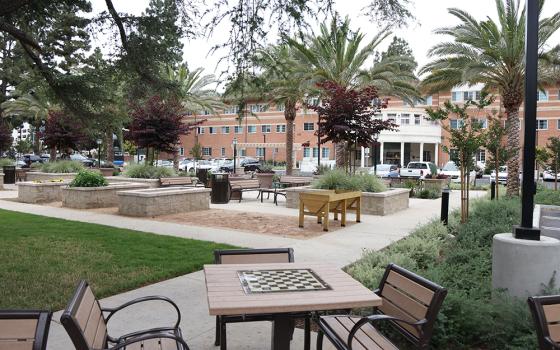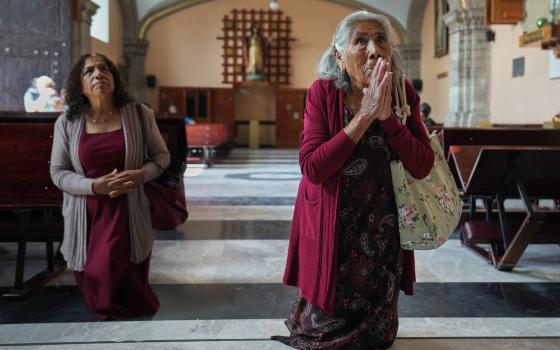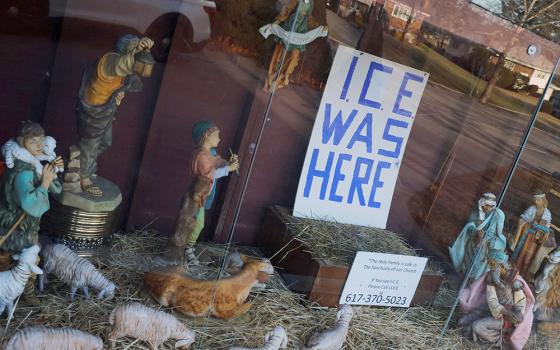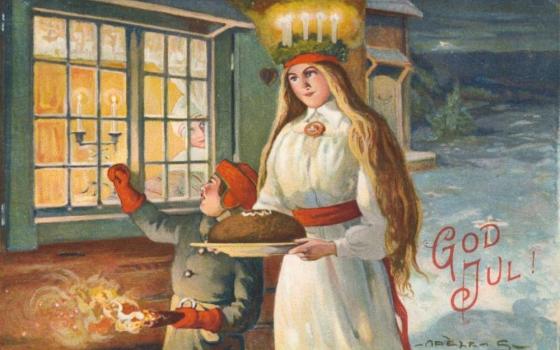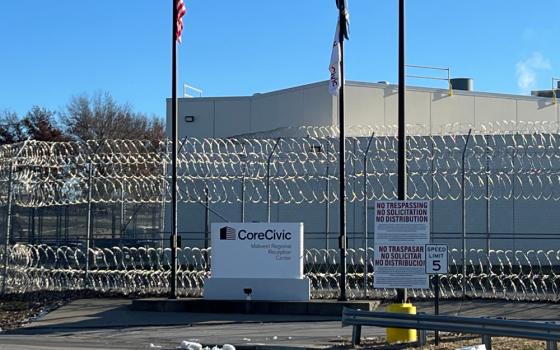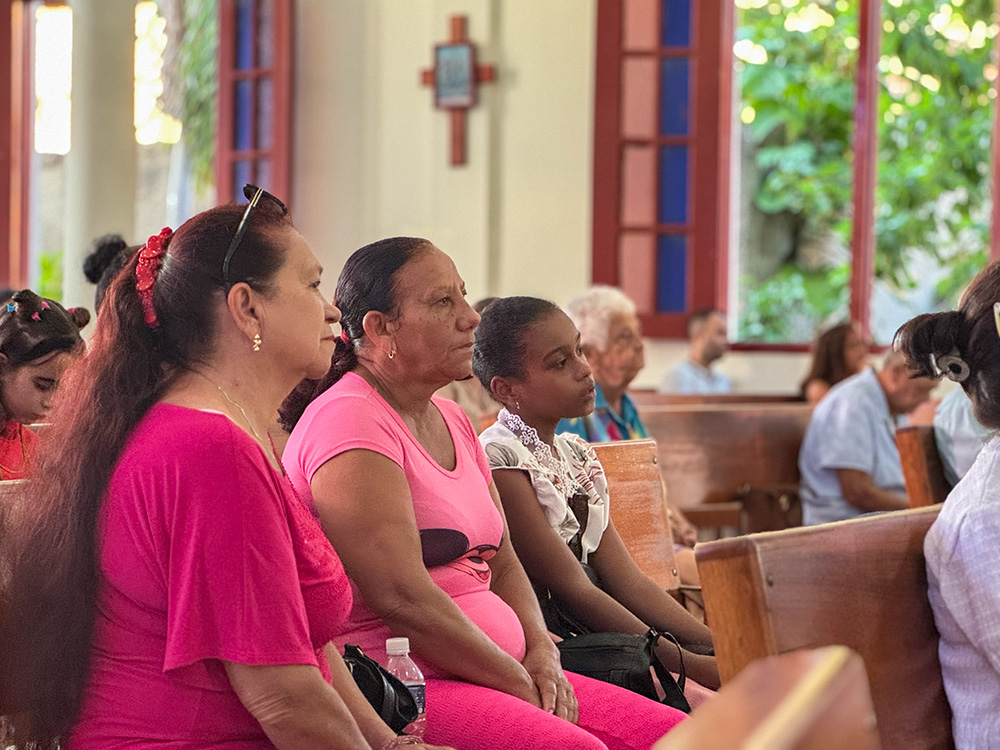
Churchgoers at Our Lady of Mount Carmel in Cueto, in eastern Cuba, listen during Sunday Mass Nov. 16, 2025. The church normally fills up, parishioners said, but many members were absent as they’ve fallen ill to mosquito-transmitted viruses. (NCR photo/Rhina Guidos)
You can't go anywhere on the island without hearing about "el virus," including during Sunday Mass at Our Lady of Mount Carmel in Cueto, eastern Cuba. Women rubbed their wrists and massaged their ankles Nov. 16 as they showed other church members what the virus had left them with: abnormally swollen joints and pain.
The church normally needs extra chairs to accommodate attendance, parishioners said, but the chikungunya virus, suspected of causing mass illness on the island, has recently kept many away.
Before being pummeled by Hurricane Melissa in late October, chikungunya (pronounced chee-kuhn-goon-nyah) and other mosquito-transmitted viruses had started causing illness among Cubans in the province of Matanzas as early as July. But infections quickly spread to the rest of the island following Hurricane Melissa when mosquitos began thriving among piles of storm debris, garbage that hasn't been picked up and puddles that haven't dried.
The infectious bites have led to an untold number of Cubans suffering from high fevers, severe headaches, painful rashes and debilitating joint pain, emptying workplaces as well as church pews.
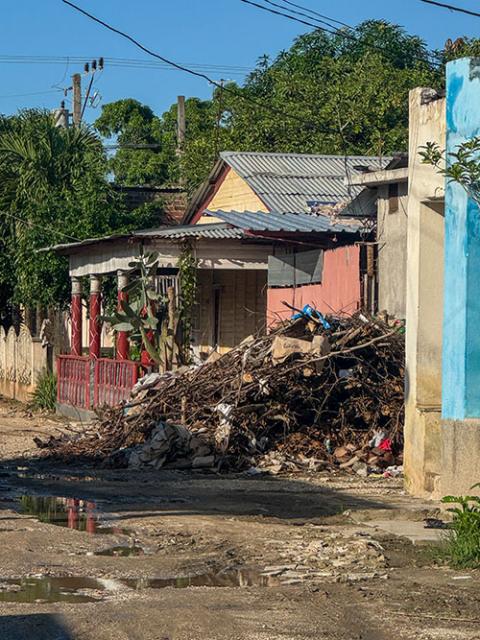
Debris left over from Hurricane Melissa piles up in front of a house in Velasco, Cuba, on the eastern part of the island, Nov. 15, 2025. (NCR photo/Rhina Guidos)
Dr. Francisco Durán, Cuba's top epidemiologist, described in mid-November the number of infections due to the chikungunya virus as "acute," saying that about 30% of the population had been infected. He added that other related diseases, such as dengue, also are making the rounds.
In Catholic Church circles, a convent in Havana closed to the public in November because of a suspected chikungunya outbreak; three out of the island's 12 active bishops did not attend the episcopal conference's annual Nov. 10-13 meeting in Havana "because of the viruses currently affecting so many Cubans," the organization said in a statement. Another prelate became ill during the gathering and another bishop had earlier been sick with a suspected mosquito-transmitted disease; some scrambled to replace sick priests to celebrate Sunday Masses and women religious raced to care for the sick as some of their members, too, came down with suspected cases of chikungunya.
The viral illnesses come on the heels of Cuba's slow recovery from Hurricane Melissa, which made landfall Oct. 29 in Santiago de Cuba in the eastern part of the island as a Category 3 storm. The province is home to the sanctuary of El Cobre where Catholics venerate the island's patron Our Lady of Charity. The shrine was damaged by the storm.
"The national tragedy caused by the cyclone [hurricane] now adds to the already difficult daily reality of our people, with shortages of basic goods, prolonged and frequent power outages, and viruses and diseases spreading," the island's bishops said in an Oct. 30 statement. They asked for help from outside the island as well as from Cubans who had something to spare.
They requested "food, clothing, mattresses, household items, roofing materials ... to help many brothers and sisters, especially the many elderly living alone and all those who are experiencing this moment with sadness and dejection."
Help from Catholic organizations such as the Miami Archdiocese, Catholic Relief Services, and Caritas, the church's global humanitarian arm, has arrived and more is expected, but none of it can help with the viral outbreaks, which have no cure.
Advertisement
In Havana, Carmelite Missionary of St. Joseph Sr. Noemy Ayala said fear of the viruses has also affected those outside Cuba who want to help with hurricane relief but are too afraid of traveling to the island and getting sick.
"This health situation has seen a drop in visits from outside," she said.
The U.S. Centers for Disease Control and Prevention issued a travel alert in October because of the earlier outbreak.
Fr. Manuel Vega, pastor of Jesus on the Mount Parish on the outskirts of Havana, said that while the church's main purpose is not to be an aid organization, its members have mobilized to help because of the Gospel teachings about charity.
Even an environment of scarcity and hardship, where a carton of eggs can cost as much or more than a month's wages on the island, a small group of Catholics from Holguín hitched a ride with their bishop, Emilio Aranguren Echeverria, on World Day of the Poor as he traveled to celebrate Mass an hour away in Cueto. They dropped off clothes and anything they could find for those affected in the town, where the hurricane tore off roofs and where residents were still trying to dry out mattresses and furniture in the sun almost three weeks after the storm hit.
"What the church is asking is that, collecting little by little, they share what little they have ... and, thank God, they are responding, they are responding," Ayala said. "Cubans in general show a lot of solidarity."

Catholic volunteers load a three-wheeled car with donations in Velasco, Cuba, Nov. 15, 2025, as they distribute donations for those affected by Hurricane Melissa at the end of October. (NCR photo/Rhina Guidos)
But what they can't help others with is the spread of the viruses. Lack of fuel, in large part affected by the U.S. embargo, makes it difficult to move trash piles and debris where mosquitos thrive. Blackouts that last almost half the day or more are a daily occurrence, and they drive Cubans to open windows and doors to stay cool. But that temporary relief also allows the disease-carrying mosquitos to enter, infecting a population with already weakened defenses due to poor nutrition.
Some fear what the rest of the year will look like for the island, given the destruction of crops left in the wake of the hurricane. Surveying damage immediately after the storm, Patrick Oppmann of CNN's Havana bureau said the loss of crops on the island "is a big problem for Cuba" since it was counting on those crops to get by.
At the Basilica of Our Lady of Charity Nov. 16, Santiago de Cuba Archbishop Dionisio García Ibáñez thanked those who have helped Cuba, but said no matter how much help arrives on the island, it never seems to be enough because of the island's great needs. The church can channel the aid it receives, but most of all it wants to channel the hope that can be found through God in times of adversity on an island that has seen its share, he said.
"Are we going to give out gold and silver? No. That's what the Acts of the Apostles says. We are going to give you Christ, who died and rose again ... that is what we are going to give you. And along with that, our closeness, our help, and everything else," he said. "The church has had so many difficulties, as many difficulties as the rest of the people. But we are willing to lift your spirits. … How many cyclones have passed through? And we have always tried to get back up."

